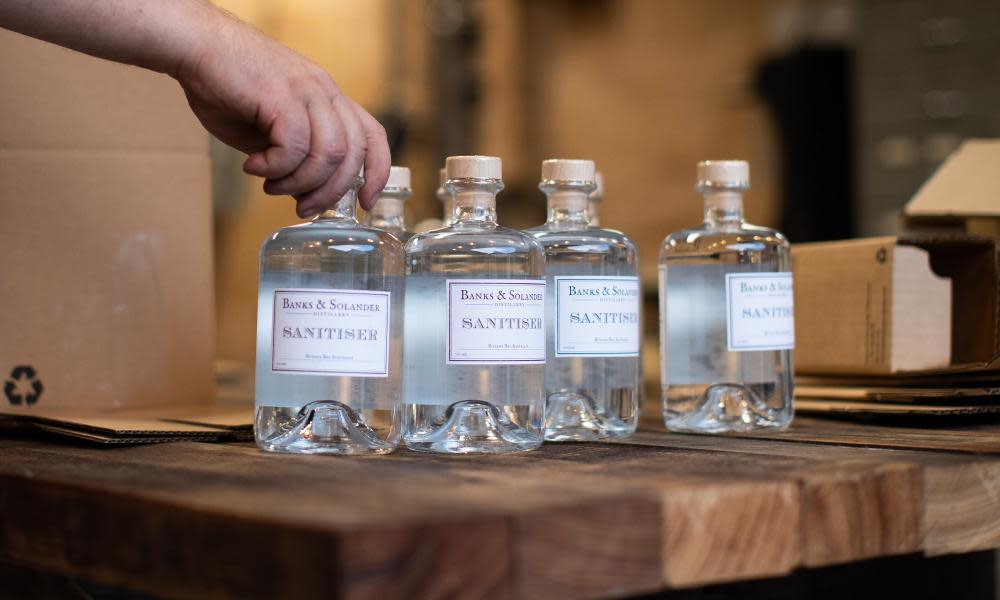Australian distillers who made sanitiser left with unsold product as cheap imports flood market

Australian distillers that made a rapid pivot into hand sanitiser manufacturing at the height of the Covid-19 crisis have been left with hundreds of thousands of litres of unsold product, as cheap and less effective imports flood the market.
Gin and whiskey distillers, ethanol refiners and bioenergy representatives encouraged by the federal government to meet emergency needs in March are calling for a plan to safeguard the emerging industry so Australia can respond to future market shocks.
The vice-president of the Australian Distillers Association, Cameron Syme, said he had been invited to a roundtable in March with the minister for industry, science and technology, Karen Andrews, who called on local businesses to meet Australia’s needs.
“I wasn’t interested in making hand sanitiser, but I’d received three emails from GPs and then the call to arms from the federal government,” Syme told Guardian Australia. “I said to Andrews: are we really going to be required, because we’d rather go about our business rather than invest in new equipment? We were told: no, you are needed.”
Syme, the head of the Great Southern Distilling Company and Margaret River Distilling Co in Western Australia, said he had invested $150,000 in equipment to produce the ethanol required, and supplied 18,000 litres of sanitiser in eight weeks.
He has been left with 10,000 bottles of sanitiser, plus the raw materials and packaging for 20,000 more.
Syme said it was difficult to compete on price with overseas imports because a Therapeutic Goods Administration exemption made to fast-track local production during the pandemic required Australian producers to meet 80% ethanol levels or 75% isopropyl levels recommended by the World Health Organization to protect against Covid-19, whereas overseas competitors are able to produce a cheaper product with lower ethanol levels.
“We stepped up in a time of crisis, and have been left financially holding the baby at the end,” he said.
Other distillers represented by the ADA are in a similar position, with dozens having contributed to up to a quarter of a million litres of hand sanitiser a week at the height of the crisis.
“We reached out to Andrews several weeks ago, telling her distilleries are getting burnt by hand sanitiser,” Syme said. “We’re still waiting to hear back.”
A spokesperson for Andrews told Guardian Australia conversations were “ongoing” with the ADA and other stakeholders in the hand sanitiser supply chain. “The Commonwealth has been helping connect manufacturers with potential customers – both directly and through the establishment of an online match-making platform.”
David Szymczak, the head of United Petroleum’s biorefinery in the Queensland town of Dalby, said his facility had switched from grain-based ethanol fuel to medical-grade ethanol as the pandemic escalated.
“I wouldn’t say we’re completely happy with the government, there’s been a lot of talk but not much action,” he told Guardian Australia. “There’s roundtables, discussions, but in the practical world of making things happen, they should be more supportive and ensure contracts are going to Australian companies rather than imported from China.”
Shahana McKenzie, the chief executive of Bioenergy Australia, was also invited to take part in the hand sanitiser roundtable. “What was not part of that roundtable process was a prediction or a plan for what would happen once the immediate crisis was over and ensuring these producers would not be left in a worse financial position than they went into it,” she said.
McKenzie called on the federal government to consider policies to support local production of critical supplies, and for consistent labelling of all hand sanitisers so consumers can know if products meet WHO requirements.
Andrews’ spokesperson said all hand sanitiser products were required to display the list of ingredients prominently and legibly: “For example, both domestically produced and imported cosmetic hand sanitiser products must meet mandatory labelling standards for cosmetics.”
Elise Bant, a professor of private law and commercial regulation at the University of Western Australia, said consumer expectations of hand sanitiser had evolved during the pandemic.
“There is a regulatory gap in regard to cosmetic sanitiser,” she said. “Strictly speaking [you can] call something a ‘sanitiser’ if it kills some germs, but that’s not what most consumers understand by the word any more.”
Consumers now expected sanitiser to be capable of killing coronavirus, she said.

 Yahoo News
Yahoo News 
